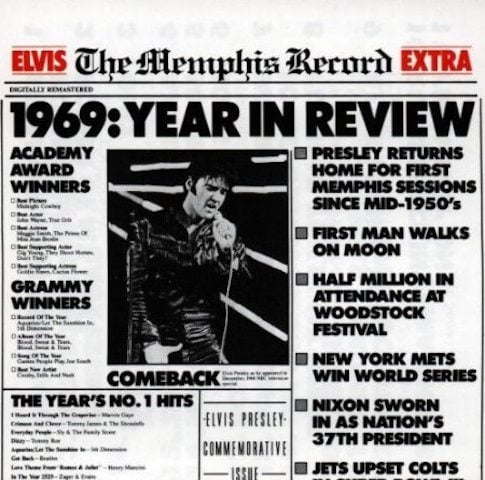King of rock ‘n’ roll returns home to record masterpiece
In 1987, the compact disc was quickly becoming the preferred format for music lovers and RCA records finally released some of Elvis Presley’s work on CD. The company released four albums in August of that year and one of those four releases was The Memphis Record — 1969: The Year in Review.
The work on this CD was recorded in 1969 when Presley returned home to Memphis for the first time since his early days with Sun Records, where he recorded alongside Johnny Cash, Jerry Lee Lewis and others.
After a stint at the top of the charts in the 1950’s, Presley enlisted in the Army (at the behest of manager Colonel Tom Parker). After serving in Korea, Presley went to Hollywood and made a slew of movies (most of which were forgettable, and in Presley’s on words “silly.” Those movies did spawn some hit singles, but it was painfully obvious that Presley yearned to return to the stage and studio.
In 1968, he had his nationally televised comeback special concert. A more intimate show was also released a short time later. In One Night with You, Elvis played a small show with his early band for a small artist. Trouble is: he was confined to a chair because he didn’t have a guitar strap. His vocal performance, however, was as passionate as it was in his early shows during the previous decade.
In 1969, Elvis returned to the Volunteer State for some studio sessions with a band that had just finished a session with Neil Diamond, one of the hottest artists of the day.
No one in Memphis really knew what to expect when the King returned home, but the resulting work was released in 1987 on CD, and is, undoubtedly, the best work of his career.
Many have said that the album, which combines the work originally released on Back in Memphis and From Elvis in Memphis, is truly a masterpiece in every sense. Here, Presley covers R&B classics such as “Stranger in My Own Hometown” and “Only the Strong Survive.”
The album (like the majority of Presley’s work) is comprised completely of songs written by others. Elvis goes country here with a cover of Hank Snow’s, “I’m Movin’ On,” and Glen Campbell’s hit, “Gentle on My Mind,” and “True Love Travels on Gravel Road.”
Presley had some big hits on this album including “Suspicious Minds” and “In the Ghetto,” which was written by Mac Davis. “Ghetto” was one of two Davis-penned tunes recorded in Memphis. The other, “Don’t Cry Daddy,” was also a hit for the King.
Other classics here include: Burt Bacharach’s “Any Day Now,” which was later released by Ronnie Milsap (who played piano on Presley’s recording). “Kentucky Rain” and “Inherit the Wind” were written by a Los Angeles rock ‘n’ roll disc jockey, who went on to become a country star and topped the charts throughout the 70’s and 80’s. That man was Eddie Rabbitt.
The work on this album (which was released concurrently with The Sun Sessions, Elvis Presley’s Top Ten Hits, and The Number One Hits, exhibits Presley’s wide and eclectic musical taste as well as his vocal versatility.
It also proves that any song the King sang would ultimately become his. It is also a testament that Elvis was at his best when he rocked. Nowhere is this more evident than in “After Loving You” and “Long Black Limousine,” both mournful and grieving songs. Elvis’ passionate performance on these tunes, however, makes these instant rock classics.
Upon its original release in 1987, the alum’s material was fresh. And it still is today, despite being nearly two decades old. Without Parker calling the shots, Elvis appears to be having fun for the first and only time in his illustrious career.
With these songs, Presley recaptures his roots as a performer for perhaps the last time in his career.
As a rock purist, however, one would have to find this work somewhat bittersweet. When Presley emerged on the scene in the 1950’s, he was abhorred by old folks. Here, he begins the process of selling out that would ultimately destroy him and lead to his death less than a decade later.
The work here, however, is nothing short of brilliant as was RCA’s repackaging of the material. The CD and vinyl releases of the 23-song compilation arrived in stores with the cover being a copy of an issue of The Memphis Record, a Tennessee newspaper chronicling the events of 1969.








